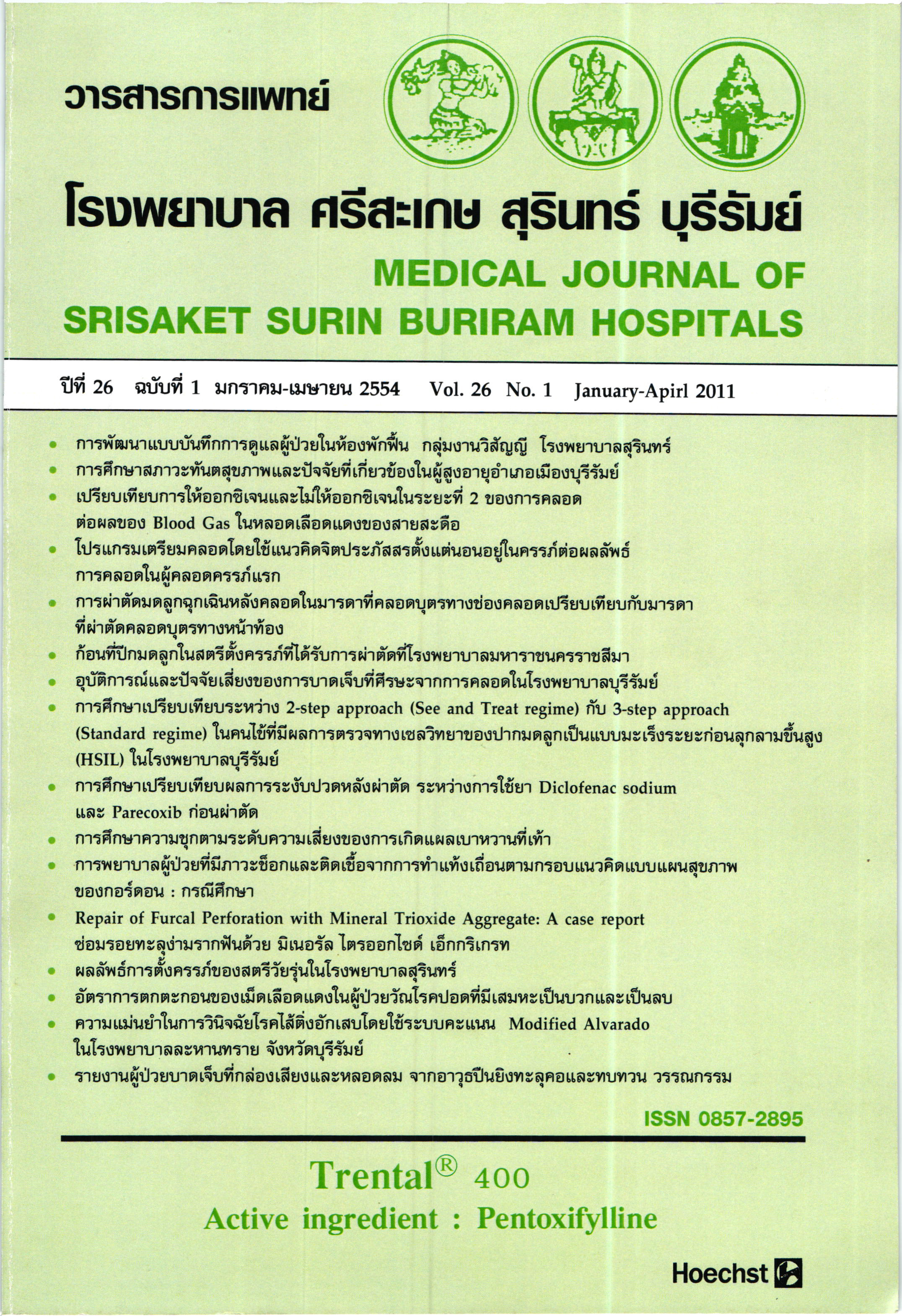การศึกษาเปรียบเทียบผลการระงับปวดหลังผ่าตัด ระหว่างการใช้ยา Diclofenac sodium และ Parecoxib ก่อนผ่าตัด
Main Article Content
บทคัดย่อ
บทนำ: การป้องกันการปวดด้วยวิธี preemptive analgesia ด้วยยากลุ่ม NSAID และ selective cox-2 inhibitors สามารถทำได้หลายวิธีและหลายชนิดยา
วัตถุประสงค์: เพื่อเปรียบเทียบผลการระงับปวดหลังผ่าตัดระยางค์ส่วนล่าง ระหว่างการใช้ยา Parecoxib และ Diclofenac sodium ก่อนผ่าตัด
วิธีการศึกษา: เป็นการศึกษาแบบ randomized controlled trail ในผู้ป่วยอายุระหว่าง 15-75 ปีได้ รับการผ่าตัดระยางค์ส่วนล่าง (lower extremities) โดยลุ่มตัวอย่างแบ่งผู้ป่วยเป็น 2 กลุ่ม กลุ่มที่ 1ได้รับ Parecoxib 40มิลลิกรัม กลุ่มที่ 2 ได้รับ Diclofenac sodium 75มิลลิกรัม เข้ากล้ามก่อนผ่าตัดอย่างน้อย 30 นาที ผู้ป่วยและแพทย์ผ่าตัดไม่ทราบชนิดของยาที่ได้รับ ผู้ป่วยได้รับการฉีดยาชาเข้าช่องไขสันหลังเพื่อผ่าตัด บันทึกคะแนนความปวด (Visual Analog scale) หลังผ่าตัด ตั้งแต่ที่ห้องพักฟื้นถึง 24 ชั่วโมงหลังผ่าตัด ผู้ป่วยทุกรายได้รับการระงับ ปวดหลังผ่าตัดด้วยวิธี Patient Controlled Analgesia (PCA) บันทึกปริมาณยาที่ได้รับผลข้างเคียงที่เกิดขึ้นใช้สถิติ ร้อยละ ค่าเฉลี่ย Chi-square test, Fisher exact’s test, student T test, ANOVA
ผลการศึกษา: ผู้ป่วย 40 ราย กลุ่มที่! และ 2 อย่างละ 20 ราย อายุเฉลี่ย 38.20 ปี และ 48.95 ปี ตาม ลำดับ ส่วนใหญ่ได้รับการวินิจฉัย facture shaft of femur จำนวน 7 ราย (ร้อยละ 35), 5 ราย (ร้อยละ 25) ระยะเวลาผ่าตัดเฉลี่ย 49.75 (29.80) และ 44.75 (20.55) นาที ในกลุ่ม ที่ 1 และ 2 ตามลำดับ ไม่พบความแตกต่างอย่างมีนัยสำคัญทางสถิติ ด้านข้อมูลทั่วไป พบว่า คะแนนความปวดเฉลี่ยสูงสุดที่ 24 ชั่วโมงหลังผ่าตัด เป็น 3.45 และ 2.95 ตามลำดับ โดยไม่พบความแตกต่างอย่างมีนัยสำคัญทางสถิติ ปริมาณยามอร์ฟีนที่ได้รับ24 ชั่วโมงหลังผ่าตัด เฉลี่ย 22.40 (17.73), 15.55 ( 11.98) มิลลิกรัม ในกลุ่มที่ 1 และ 2 ตามลำดับ โดยไม่แตก ต่างอย่างมีนัยสำคัญทางสถิติเช่นกัน
สรุป: การใช้ยา Diclofenac และ Parecoxib ก่อนผ่าตัด สำหรับผู้ป่วยผ่าตัดกระดูกขา มีผล preemptive analgesia ช่วยระงับปวดหลังผ่าตัด และใช้ปริมาณมอร์ฟีนใน 24 ชั่วโมงหลังผ่าตัด ไม่แตกต่างกัน
Article Details
เอกสารอ้างอิง
Sinatra R. Role of COX-2 inhibitors in the evolution of acute pain management. J Pain Symptom Manage 2002 ;24 (1 Suppl): S18-27.
White PF. The changing role of non-opioid analgesic technigues in the management of postoperative pain. Anesth Analg 2005; 101: S5-22.
Michaloliakou C, Chung F, Sharma S. Preoperative multimodal analgesia facilitates recovery after ambulatory laparoscopic cholecystectomy. Anesth Analg 1996; 82: 44-51.
Llan Dl, Liporace FA, Rosen J, Cannavo D. Efficy of rofecoxib for pain control after knee arthroscopy: a prospective, randomized, double-blinded clinical trial. Arthroscopy 2004; 20: 813-8.
Ekman EF,Wahba M, Ancona F. Analgesic efficacy of perioperative celecoxib in ambulatory arthroscopic knee surgery: a double-blind,placebo control study. Arthroscopy 2006; 22: 635-42.
White PF. The role of non-opiod analgesic techniques in the management of pain after ambulatory surgery. Anesth Analg 2002; 94: 577-85.
Puura A, Puolakka P, Rorarius M, Salmelin R, Lindgren L. Etoricoxib pre-medication for post-operative pain after laparoscopic cholecystectomy. Acta Anaesthesiol Scand 2006; 50: 688-93.
Bardrn J, Edwords JE, Mcqury HJ, Moose RA. Oral valldecoxib and injected parecoxib for acute postoperative pain: a quanlitative systematic review. BMC Anesthesiol 2003; 3: 1-12.
Ong Cliff KS, Lirk Philipp, Seymour RA, Jenkins BJ. The efficacy of preemptive analgesia for acute postoperative pain management ะ a meta-analysis. Anesth Analg 2005; 100: 757-73.
วิชัย อิทธิชัยกุลฑล, นฤมล ประจันพาณิชย์, จุติมา โฆษิตชัยวัฒน์, ธีรยุทธ อินทปัญณ์. การศึกษาเปรียบเทียบฤทธ์แก้ปวดขอยา celecoxib และ parecoxib ที่ให้ก่อนผ่าตัดในผู้ป่วยที่มารับการผ่าตัดเปลี่ยนข้อสะโพกหรือข้อเข่า. J Med Assoc Thai 2010; 95(8): 937-942.
Moiniche S, Romsing J, Luhl JB, Tramer MR. NSAIDs and the risk of operative site bleeding after tonsillectomy : a qualitative systematic reviews. Anaesth Analg 2003; 96: 68-77.
Punnagai K, Gunasekaran K, Vijaybabo K, Josephine IG. Efficacy and safety of Diclofenac sodium and Etoricoxib in controlling postextraction dental pain a randomized open label comparative study. IJBM 2010; 1 : 1-8.


